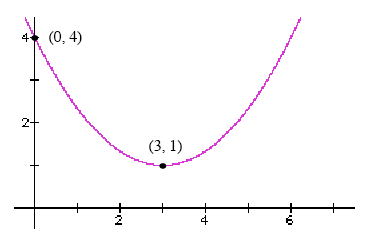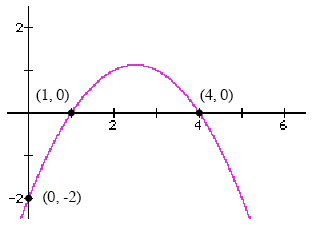|
Polynomial EquationsPolynomial Equations in DisguiseThe standard format (or standard form) for the formula of a polynomial equation is: y = c0 + c1·x + c2·x2 + ... + cn·xn where the powers of x must be positive integers and the letters c0, c1, … , cn represent numbers. The formulas of polynomial equations sometimes come expressed in other formats, such as factored form or vertex form. The specific format that the formula of a polynomial equation is expressed in does not matter so much – you can always convert the formula to standard form by foiling to check that the formula really is the formula of a polynomial equation. Example Figure 2 shows the graph of a quadratic equation. (a) Find a formula for the quadratic equation expressed in vertex form. (b) Find a formula for the quadratic equation expressed in standard form. (c) Is the equation that you have found a formula for a polynomial equation or not?
Figure 1: Find the formula of this quadratic equation. Solution (a) The vertex form of a quadratic equation looks like: y = a · (x - h)2 + k, where the letter h is the x-coordinate of the vertex and the letter k is the ycoordinate of the vertex. Figure 1 shows that the x-coordinate of the vertex is equal to 3 and that the y-coordinate of the vertex is equal to 1. This means that the vertex form of this quadratic will be: y = a · (x - 3)2 +1. All that remains is to find the numerical value of the constant a. To do this, you can use the x- and y-coordinates of any other point (i.e. other than the vertex) that lies on the quadratic – for example the point (0, 4) shown in Figure 2. To work out the value of a we will plug x = 0 and y = 4 into the vertex form and then solve for a. 4 = a · (0 - 3)2 +1. 4 = a · 9 +1. 3 = a · 9.
So, the equation for the quadratic equation shown in Figure 1 (expressed in vertex form) is:
To convert this equation from vertex form to standard form, you can expand by FOILing and then collect like terms.
So, the equation for the quadratic equation shown in Figure 2 (expressed in standard form) is:
(c) This is a polynomial equation because the formula consists of powers of x added together. All of the powers that appear are positive integers. Example Figure2 (see below) shows the graph of a quadratic equation. (a) Find a formula for the quadratic equation expressed in factored form. (b) Find a formula for the quadratic equation expressed in standard form. (c) Is the equation that you have found a formula for a polynomial equation or not?
Figure 2: Find the formula of this quadratic equation. Solution (a) The x-intercepts of the quadratic shown in Figure 2 are located at x = 1 and x = 4. This means that the factored form of the quadratic equation must look something like this: y = a · (x -1) · (x - 4). The factored form must have a factor of (x - 1) to ensure that when you plug in x = 1 the value of y will be equal to zero. The factored form must also have a factor of (x - 4) to ensure that when you plug in x = 4 the value of y will be equal to zero. To determine the numerical value of a you can plug in the x- and y-coordinates of any other point on the quadratic graph (i.e. any point other than one of the xintercepts) and solve for a. Figure 2 shows that the point (0, -2) lies on the graph, so you can plug in x = 0 and y = -2 into the factored form. Doing this: -2 = a · (0 -1) · (0 - 4) -2 = a · 4
So, the equation of the quadratic equation from Figure 2 (written in factored form) is:
(b) To convert this equation to standard form, you can expand by FOILing and then simplify (if necessary). Doing this:
(Multiply through by
(c) This is a polynomial equation because the formula consists of powers of x added together. All of the powers that appear are positive integers. |
| Copyrights © 2005-2025 |



